GIS-Based RUSLE Reservoir Sedimentation Estimates: Temporally Variable C-Factors, Sediment Delivery Ratio, and Adjustment for Stream Channel and Bank Sediment Sources
Abstract
1. Introduction
2. Material and Methods
2.1. Study Sites
2.1.1. General Description
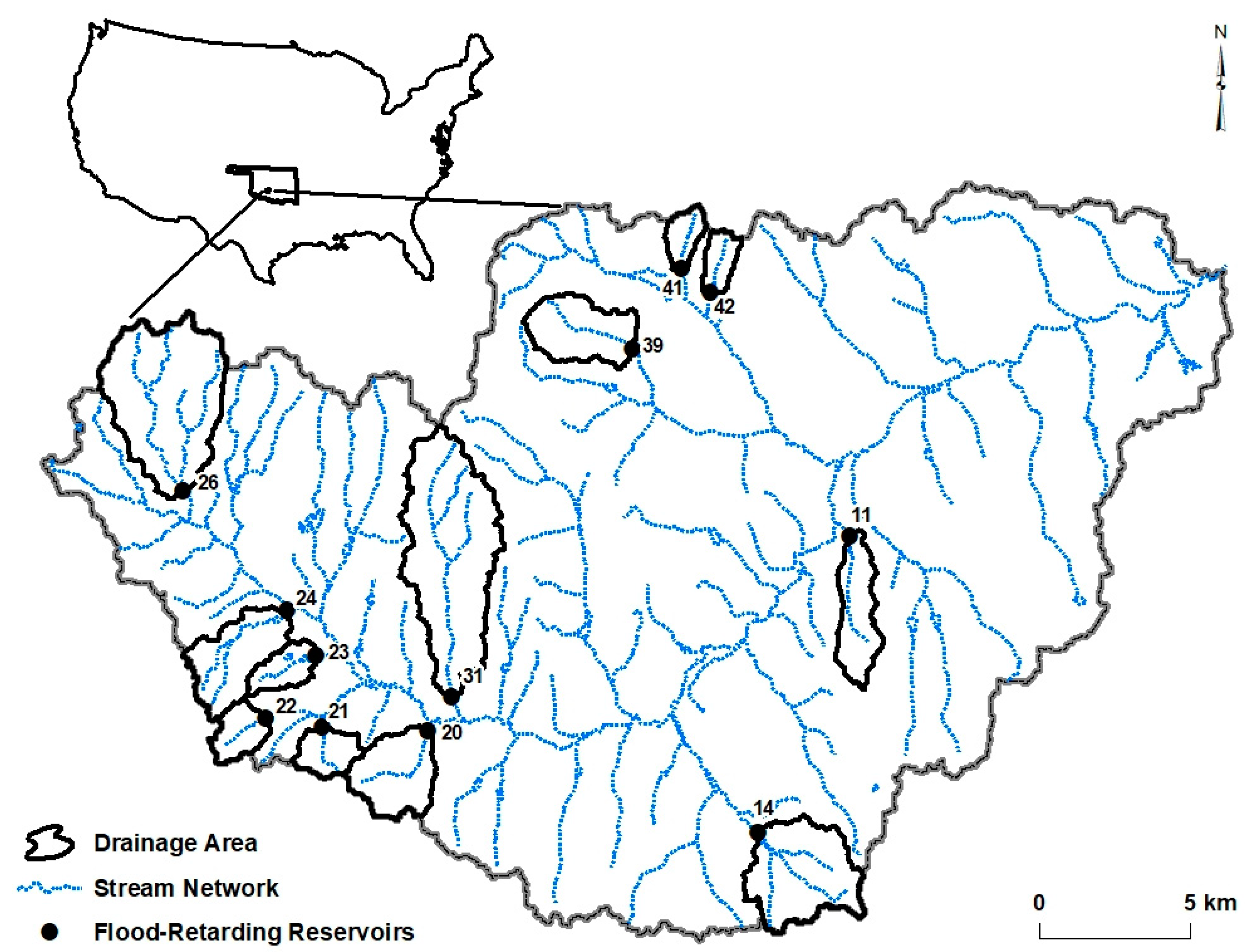
2.1.2. Watershed and Stream Geomorphic and Topographic Variables
2.1.3. Stream Corridor Variables
| % Watershed Area under Land Cover Type | Bathymetric Information | ||||||||
|---|---|---|---|---|---|---|---|---|---|
| Watershed/ Reservoir ID | * Date Construction Completed (dd/mm/yr) | WA (km2) | Crop | Grass | Tree/Shrub | Subdominant Land Cover ID | Survey Date | Impoundment Period (yr) | Sediment Volume (m3) |
| 11 | 6 November 1973 | 4.9 | 10 | 73 | 15 | Grass | 24/05/2012 | 39.0 | 36,991 |
| 14 | 14 April 1978 | 10.8 | 5 | 75 | 16 | Grass | 15/05/2012 | 34.1 | 146,856 |
| 20 | 27 October 1982 | 6.7 | 2 | 60 | 33 | Tree/Shrub | 22/05/2012 | 29.6 | 115,906 |
| 21 | DD May 1970 | 2.8 | 3 | 80 | 11 | Grass | 22/05/2012 | 42.1 | 37,485 |
| 22 | 8 April 1977 | 2.9 | 15 | 69 | 13 | Grass | 18/05/2012 | 35.1 | 96,917 |
| 23 | 27 July 1971 | 2.5 | 34 | 59 | 2 | Crop | 17/05/2012 | 40.8 | 24,155 |
| 24 | 8 November 1976 | 7.0 | 43 | 46 | 6 | Crop | 17/05/2012 | 35.5 | 72,256 |
| 26 | DD December 1971 | 18.0 | 42 | 50 | 2 | Crop | 16/05/2012 | 40.4 | 439,581 |
| 31 | 14 September 1978 | 19.2 | 14 | 60 | 21 | Crop | 23/05/2012 | 33.7 | 308,015 |
| 39 | 26 June 1978 | 6.3 | 1 | 56 | 35 | Tree/Shrub | 24/05/2012 | 33.9 | 69,174 |
| 41 | DD October 1969 | 2.0 | 2 | 44 | 44 | Tree/Shrub | 14/05/2012 | 42.5 | 36,868 |
| 42 | DD October 1969 | 1.9 | 4 | 66 | 24 | Tree/Shrub | 25/05/2012 | 42.6 | 27,867 |
2.1.4. Within-Channel Variables
2.2. GIS-Based RUSLE/SEDIMENTATION
2.2.1. RUSLE Model Description
2.2.2. GIS-Based RUSLE Module
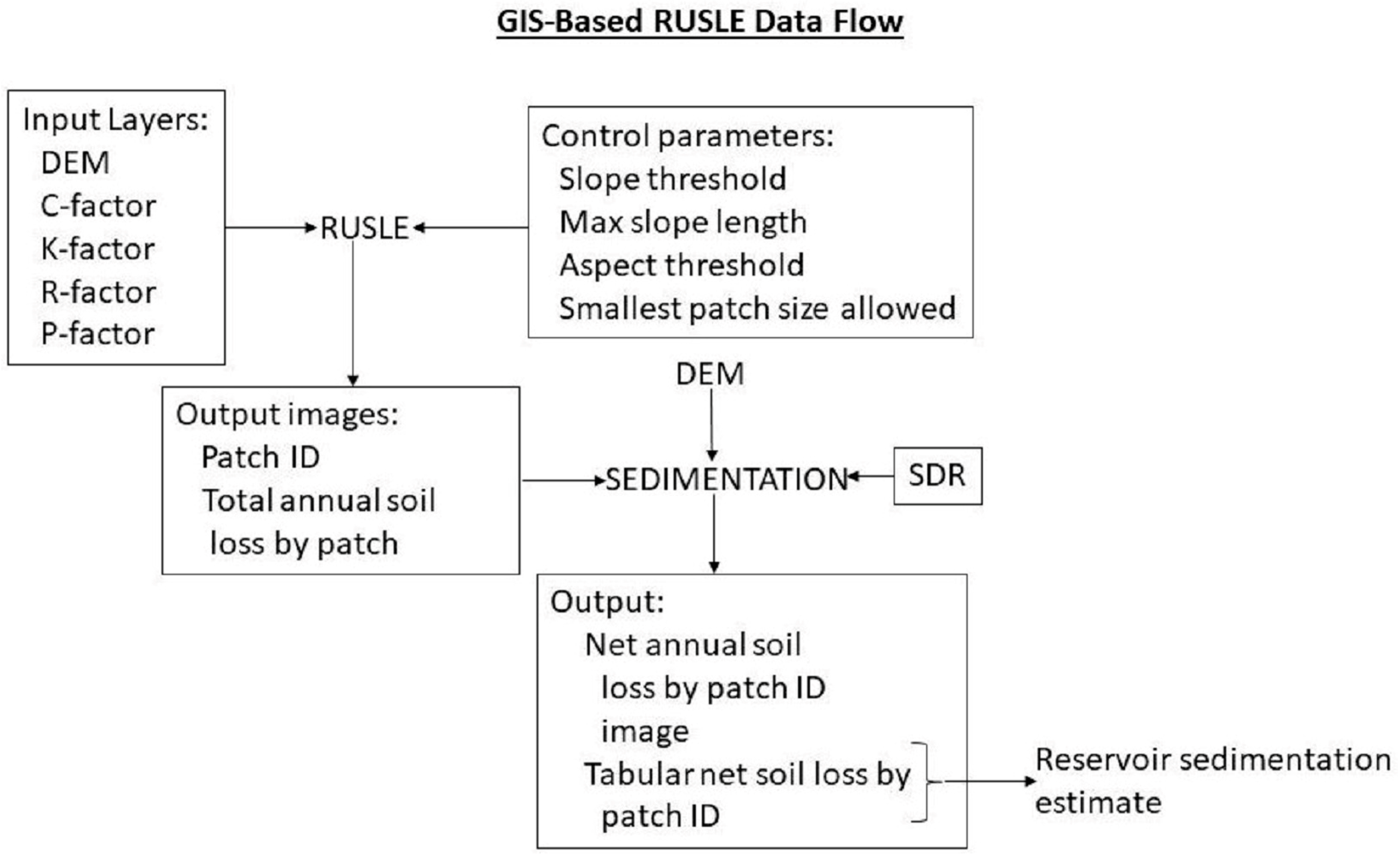
2.2.3. GIS-Based RUSLE Inputs
2.2.4. SDR Models
| SDR Models | ||||
|---|---|---|---|---|
| Watershed ID | Equation (2) | Equation (3) | Equation (4) | Equation (5) |
| 11 | 0.254 | 0.474 | 0.257 | 0.387 |
| 14 | 0.260 | 0.435 | 0.213 | 0.351 |
| 20 | 0.248 | 0.458 | 0.238 | 0.372 |
| 21 | 0.372 | 0.504 | 0.293 | 0.415 |
| 22 | 0.364 | 0.503 | 0.291 | 0.414 |
| 23 | 0.268 | 0.511 | 0.302 | 0.421 |
| 24 | 0.229 | 0.456 | 0.236 | 0.37 |
| 26 | 0.103 | 0.411 | 0.188 | 0.329 |
| 31 | 0.179 | 0.408 | 0.186 | 0.327 |
| 39 | 0.255 | 0.461 | 0.242 | 0.375 |
| 41 | 0.321 | 0.524 | 0.318 | 0.433 |
| 42 | 0.395 | 0.527 | 0.322 | 0.436 |
2.3. Normalized GIS-Based RUSLE Reservoir Sedimentation Estimates
2.4. Stream Bank Sediment Contributions
2.4.1. First-Order Adjustment
2.4.2. Statistical Linkages between NDRes and Watershed, Stream, Stream Corridor, and Within-Channel Variables
2.5. Statistical Analysis
3. Results and Discussion
3.1. Variability in RUSLE C- and K-Factors
3.1.1. C-Factors (Land Cover)
| Image Year | |||||
|---|---|---|---|---|---|
| Cover Type | 1981 | 1985 | 1989 | 1994 | 1997 |
| Crop | 0.471 | 0.414 | 0.179 | 0.394 | 0.445 |
| Fallow | -- | 0.002 | 0.005 | -- | -- |
| Grass | 0.488 | 0.544 | 0.752 | 0.594 | 0.537 |
| Tree/Shrub | 0.064 | 0.064 | 0.088 | 0.035 | 0.042 |
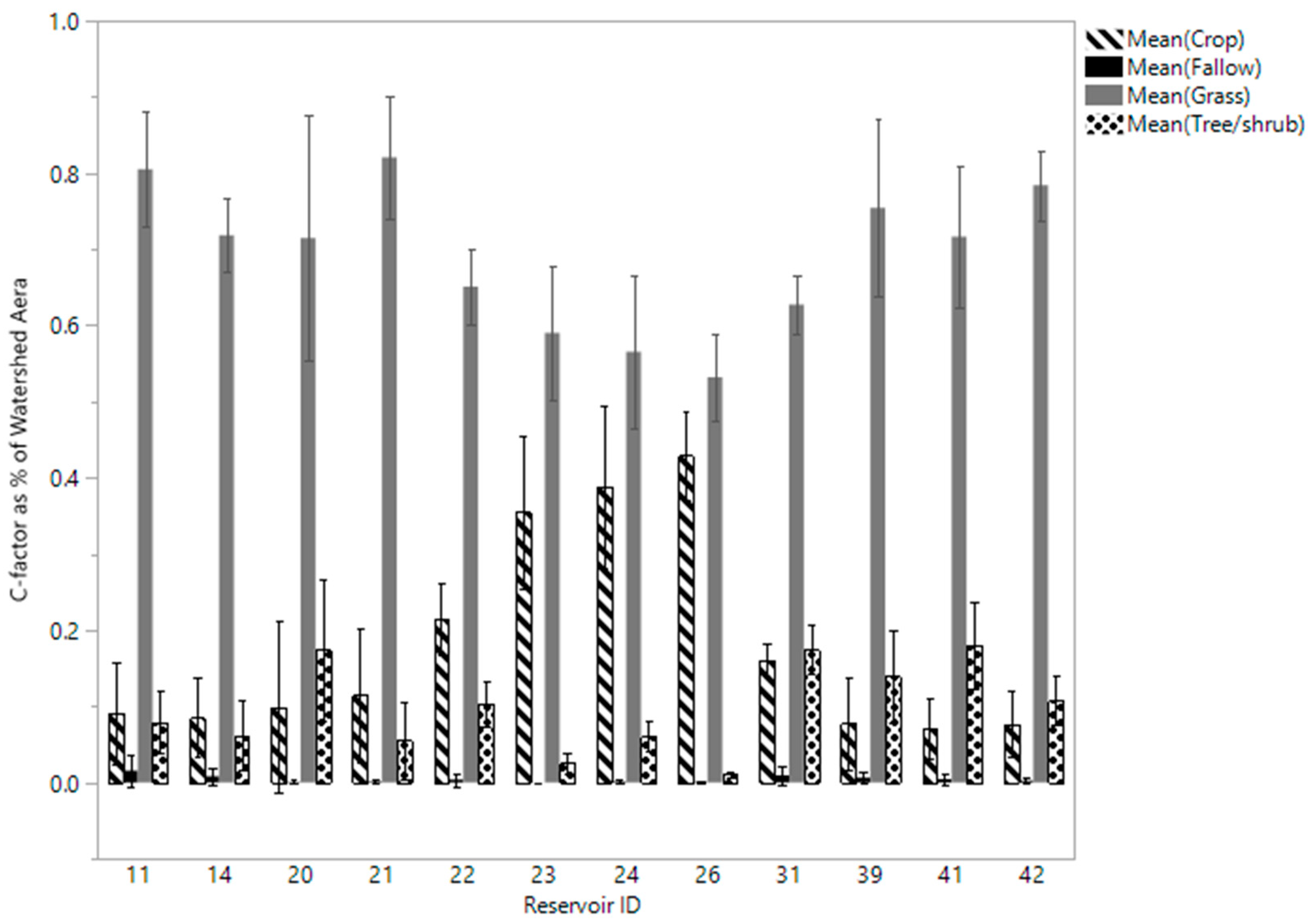
3.1.2. K-Factors
3.2. Initial Reservoir Sedimentation Analysis
3.3. Effects of Land Cover (C-factor) Date on Sedimentation Estimates
3.3.1. Date Effects Pooled over All Watersheds
3.3.2. Date Effects within Watershed Subdominant Land Cover Group
| Date | All | Crop | Grass | Tree/Shrub |
|---|---|---|---|---|
| 1981 | 0.438 | 0.510 | 0.481 | 0.323 ab |
| 1985 | 0.545 | 0.618 | 0.422 | 0.593 a |
| 1989 | 0.499 | 0.843 | 0.462 | 0.193 b |
| 1994 | 0.454 | 0.565 | 0.401 | 0.395 ab |
| 1997 | 0.595 | 0.738 | 0.667 | 0.369 ab |
3.4. Comparison of Averaged Estimated and Measured Reservoir Sedimentation
3.4.1. Between Subdominant Land Cover Groups
| Watershed Land Cover | * NDResT Least Square Mean |
|---|---|
| Crop | 0.655 a |
| Grass | 0.489 b |
| Tree/shrub | 0.374 b |
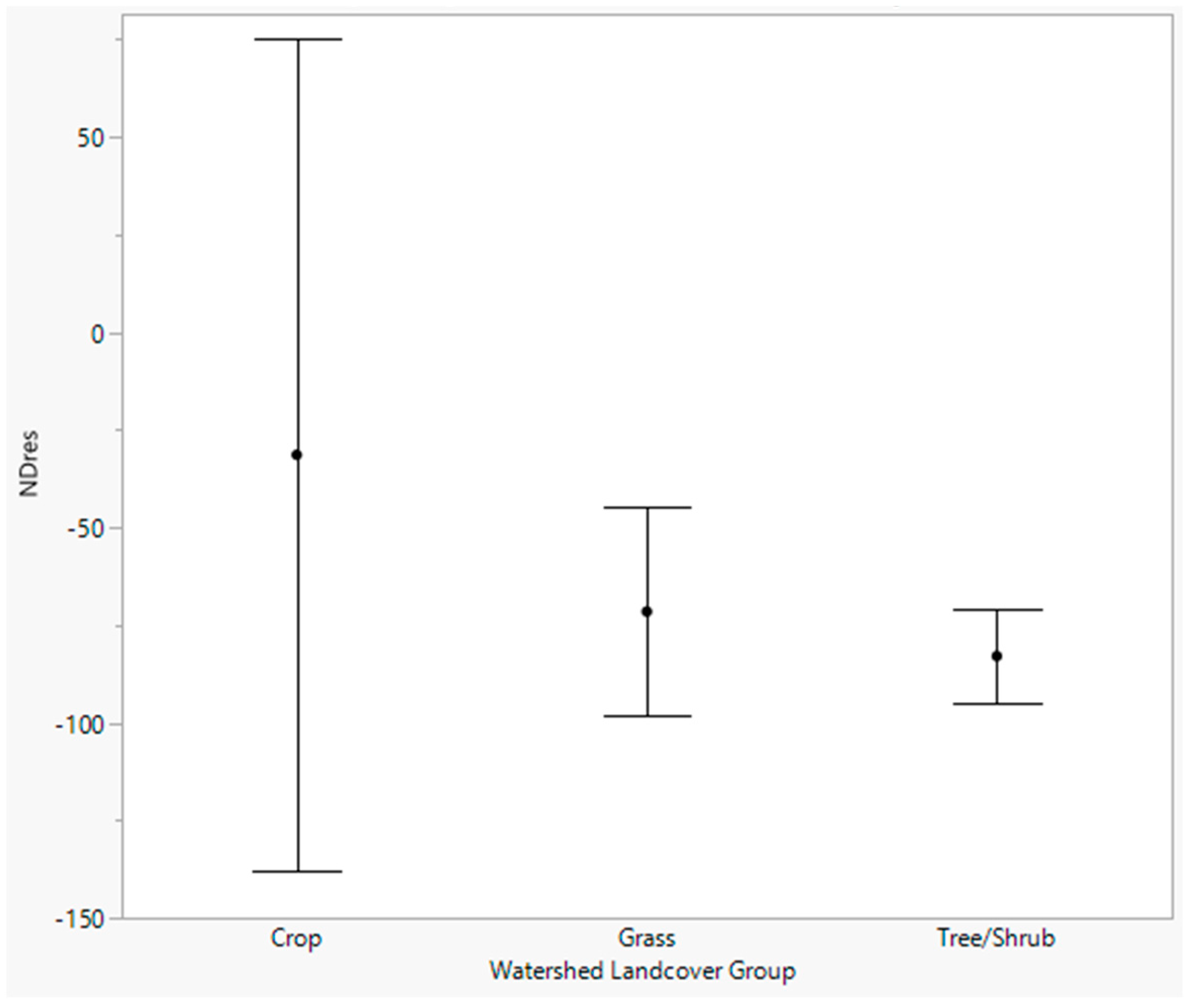
3.4.2. Between Reservoirs within Subdominant Land Cover Group
3.4.3. Across All Watersheds
| Watershed/Reservoir ID | Watershed Land Cover Group | * NDResT | NDRes Mean (%) | NDRes_adj Mean (%) |
|---|---|---|---|---|
| 24 | Crop | 0.763 a | −56.0 | −4.3 abc |
| 11 | Grass | 0.726 b | −50.0 | 8.7 a |
| 26 | Crop | 0.681 ab | −61.6 | −16.6 abcd |
| 23 | Crop | 0.679 abc | −53.4 | 1.4 ab |
| 22 | Grass | 0.589 abcd | −62.8 | −19.2 abcd |
| 41 | Tree/shrub | 0.476 abcde | −76.5 | −49.0 bcde |
| 39 | Tree/shrub | 0.417 bcde | −82.3 | −61.5 cde |
| 31 | Crop | 0.387 cde | −82.7 | −62.5 cde |
| 42 | Tree/shrub | 0.383 cde | −83.8 | −64.8 de |
| 21 | Grass | 0.370 de | −84.6 | −66.6 de |
| 14 | Grass | 0.269 e | −88.9 | −75.9 e |
| 20 | Tree/shrub | 0.222 e | −89.1 | −76.3 e |
3.5. Stream Bank Contributions—First-Order Adjustment
3.6. Watershed, Stream, Stream Corridor, and Within-Channel Variables
3.6.1. Watershed and Stream Variables
| Watershed Variables * | Stream Variables | ||||||||||
|---|---|---|---|---|---|---|---|---|---|---|---|
| Broad Group ID | WA (km2) | Wrlf (m) | %Wslope≥21 | Wvl | %WLK | %WMK | %WHK | WK | Sthal (m) | Sslope (m m−1) | Ssn |
| 1 | 7.1 | 51.0 | 1.7 | 5101 | 19 b | 66 a | 13 a | 0.33 a | 6078 | 0.011 | 1.21 |
| 2 | 7.1 | 51.5 | 1.0 | 3753 | 74 a | 19 b | 3 b | 0.21 b | 4124 | 0.015 | 1.09 |
3.6.2. Stream Corridor Variables
3.6.3. Within-Channel Variables
| Group ID | ICK * | ICSa | ICSi | %ICLK | %ICMK | %ICHK | ICPI |
|---|---|---|---|---|---|---|---|
| 1 | 0.33 a | 40.8 b | 37.2 a | 21.6 b | 78.2 a | 0.14 | 10.9 |
| 2 | 0.23 b | 59.6 a | 23.1 b | 73.9 a | 25.1 b | 0.09 | 7.6 |
3.7. Sediment Delivery Ratios (SDRs)
3.8. Watershed, Stream, Stream Corridor, and Within-Channel Variables as Predictors of NDRes
4. Conclusions
Supplementary Materials
Author Contributions
Funding
Data Availability Statement
Acknowledgments
Conflicts of Interest
Abbreviations
| Acronym | Meaning |
| %CorHK | Percentage of the 100 m stream corridor area having high K-factor soils |
| %CorLK | Percentage of the 100 m stream corridor area having low K-factor soils |
| %CorMK | Percentage of the 100 m stream corridor area having moderate K-factor soils |
| %Corslope≥21 | Percentage of the 100 m stream corridor area having slopes ≥ 21° |
| %ICHK | Weighted percentage of high K-factor soils composing the stream bank and channel |
| %ICLK | Weighted percentage of low K-factor soils composing the stream bank and channel |
| %ICMK | Weighted percentage of moderate K-factor soils composing the stream bank and channel |
| %ICWK | Weighted average K-factor of the stream bank and stream channel soils |
| %Wslope>21 | Percentage of the WA having slopes ≥ 21° |
| ANOVA | Analysis of Variance |
| BA | Bank angle (deg) |
| BFD | Bank full depth (m) |
| BFW | Bank full width (m) |
| BFW:BFD | Ratio of BFW to BFD |
| BH | Bank height (m) |
| BHR | Bank height ratio |
| BSTEM | Bank Stability and Toe Erosion Model |
| CA | Stream channel area (m2) |
| CD | Stream channel depth (m) |
| CW | Stream channel width (m) |
| CW:CD | Ratio of CW to CD |
| Corslope≥21 | Actual area of the 100 m stream corridor having slopes ≥ 21° (m2) |
| Corslope≥21:Wvl | Area within the 100 m stream corridor having slopes ≥ 21° per m of Wvl (m2 m−1) |
| DEM | Digital elevation model |
| ER | Entrenchment ratio |
| EUROSEM | European Soil Erosion Model |
| FP | Flood plain |
| FWA | Flood way area |
| GIS | Geographical information system |
| IC | Within-channel |
| ICPI | Weighted average plasticity index of the stream bank and stream channel soils |
| ICSa | Weighted average sand fraction of the stream bank and stream channel soils |
| ICSi | Weighted average silt fraction of the stream bank and stream channel soils |
| LWREW | Little Washita River Experimental Watershed |
| NDRes | Normalized difference between estimated and measured sedimentation |
| NDRes_adj | NDRes adjusted to account for stream channel/bank sediment contributions |
| NDResT | Johnson Su transformation of NDRes |
| RMSE | Root mean square error |
| RUSLE | Revised Universal Soil Loss Equation |
| RUSLE2 | RUSLE version 2 |
| SDR | Sediment delivery ratio |
| SE | Total soil erosion |
| SY | Sediment yield |
| Sslope | Stream slope (m m−1) |
| Ssn | Stream sinuosity |
| Sthal | Stream thalweg length (m) |
| USLE | Universal soil loss equation |
| USDA-NRCS | United States Department of Agriculture-Natural Resources Conservation Service |
| WEPP | Water Erosion Prediction Project |
| WRB | Washita River Basin |
| WA | Watershed drainage area (km2) |
| WHK | Percentage of watershed drainage area in high K-factor soils |
| WLK | Percentage of watershed drainage area in low K-factor soils |
| WK | Area-weighted watershed K-factor |
| WMK | Percentage of watershed drainage area in moderate K-factor soils |
| Wrlf | Watershed relief (m) |
| Wvl | Watershed valley length (m) |
References
- Moriasi, D.N.; Steiner, J.L.; Duke, S.E.; Starks, P.J.; Verser, A.J. Reservoir sedimentation rates in the Little Washita River experimental watershed: Measurement and controlling factors. J. Amer. Water Resour. Assoc. 2018, 54, 1011–1023. [Google Scholar] [CrossRef]
- Hanson, G.J.; Caldwell, L.; Lobrecht, M.; McCook, D.; Hunt, S.L.; Temple, D. A look at the engineering challenges of the USDA Small Watershed Program. Centennial Edition Trans. ASABE 2007, 50, 1677–1682. [Google Scholar] [CrossRef]
- Hunt, S.L.; Hanson, G.L.; Temple, D.M.; Caldwell, L. The importance of the USDA Small Watershed Program to the rural United States. Water Resour. IMPACT 2011, 13, 9–11. [Google Scholar]
- Allen, P.B.; Naney, J.W. Hydrology of the Little Washita River Watershed, Oklahoma; United States Department of Agriculture, Agricultural Research Service: Washington, DC, USA, 1991; ARS-90.
- Bennett, S.J.; Dunbar, J.A.; Rhoton, F.E.; Allen, P.M.; Bigham, J.M.; Davidson, G.R.; Wren, D.G. Assessing sedimentation issues within aging flood-control reservoirs. Rev. Engin. Geol. 2013, 21, 25–44. [Google Scholar]
- Ketchem, A.J.; Mathew, P.E.; Lyons, P.E.; Evans, R. Reservoir Sediment Impacts on the Rehabilitation of NRCS-Assisted Flood Control Dams in Virginia; ASABE Paper No. 1900198; American Society of Agricultural and Biological Engineers: St. Joseph, MI, USA, 2019; 3p. [Google Scholar]
- Zhang, X.C.J.; Zhang, G.H.; Wei, X.; Guan, Y.H. Evaluation of cesium-137 conversion models and parameter sensitivity for erosion estimation. J. Environ. Qual. 2015, 44, 789–802. [Google Scholar] [CrossRef]
- The Small Watershed Rehabilitation Amendments of 2000. Available online: https://www.congress.gov/bill/106th-congress/house-bill/728 (accessed on 7 August 2023).
- Laflen, J.M.; Elliot, W.J.; Flanagan, D.C.; Meyer, C.R.; Nearing, M.A. WEPP-predicting water erosion using a process-based model. J. Soil Water Conserv. 1997, 52, 96–102. [Google Scholar]
- Morgan, R.P.C.; Quinton, J.N.; Smith, R.E.; Govers, G.; Poesen, J.W.A.; Auerswald, K.; Chisci, G.; Torri, D.; Styczen, M.E. The European Soil Erosion Model (EUROSEM): A dynamic approach for predicting sediment transport from fields and small catchments. Earth Surf. Proc. Landforms J. Brit. Geomorph. Group 1998, 23, 527–544. [Google Scholar] [CrossRef]
- Kinnell, P.I. Sediment delivery ratios: A misaligned approach to determining sediment delivery from hillslopes. Hydrolog. Proc. 2004, 18, 3191–3194. [Google Scholar] [CrossRef]
- Renard, K.G.; Foster, G.R.; Weesies, G.A.; McCool, D.K.; Yoder, D.C. Predicting Soil Erosion by Water: A Guide to Conservation Planning with the Revised Soil Loss Equation (RUSLE); Agriculture Handbook No. 703; United States Department of Agriculture: Washington, DC, USA, 1997; 404p.
- Wischmeier, W.H.; Smith, D.D. Predicting Rainfall Erosion Losses—A Guide to Conservation Planning; U.S. Department of Agriculture, Handbook No. 537; United States Department of Agriculture: Washington, DC, USA, 1978.
- Shi, Z.H.; Cai, C.F.; Ding, S.W.; Wang, T.W.; Chow, T.L. Soil conservation planning at the small watershed level using RUSLE with GIS: A case study in the Three Gorges area of China. Catena 2004, 55, 33–48. [Google Scholar] [CrossRef]
- Chen, H.; El Garouani, A.; Lewis, L.A. Modelling soil erosion and deposition within a Mediterranean mountainous environment utilizing remote sensing and GIS–Wadi Tlata, Morocco. Geograph. Helvet. 2008, 63, 36–47. [Google Scholar] [CrossRef][Green Version]
- Anees, M.T.; Abdullah, K.; Nawawi, M.N.M.; Norulaini, N.A.N.; Syakir, M.I.; Omar, A.K.M. Soil erosion analysis by RUSLE and sediment yield models using remote sensing and GIS in Kelantan state, Peninsular Malaysia. Soil Res. 2018, 56, 356–372. [Google Scholar] [CrossRef]
- Kumar, A.; Devi, M.; Deshmukh, B. Integrated Remote Sensing and Geographic Information System Based RUSLE Modelling for Estimation of Soil Loss in Western Himalaya, India. Water Resour. Manag. 2014, 28, 3307–3317. [Google Scholar] [CrossRef]
- Kouli, M.; Soupios, P.; Vallianatos, F. Soil erosion prediction using the Revised Universal Soil Loss Equation (RUSLE) in a GIS framework, Chania, Northwestern Crete, Greece. Environ. Geol. 2009, 57, 483–497. [Google Scholar] [CrossRef]
- Boomer, K.B.; Weller, D.E.; Jordan, T.E. Empirical models based on the Universal Soil Loss Equation fail to predict sediment discharges from Chesapeake catchments. J. Environ. Qual. 2008, 37, 79–89. [Google Scholar] [CrossRef]
- Moges, M.M.; Abay, D.; Engidayehu, H. Investigating reservoir sedimentation and its implications to watershed sediment yield: The case of two small dams in data-scarce upper Blue Nile basin, Ethiopia. Lakes and Reser. 2018, 23, 217–229. [Google Scholar] [CrossRef]
- Kaffas, K.; Pisinaras, V.; Al Sayah, M.J.; Santopietro, S.; Righetti, M. A USLE-based model with modified LS-factor combined with sediment delivery module for Alpine basins. Catena 2021, 207, 105655. [Google Scholar] [CrossRef]
- Bufalini, M.; Materazzi, M.; Martinello, C.; Rotigliano, E.; Pambianchi, G.; Tromboni, M.; Paniccia, M. Soil erosion and deposition rate inside an artificial reservoir in central Italy: Bathymetry versus RUSLE and morphometry. Land 2022, 11, 1924. [Google Scholar] [CrossRef]
- Trimble, S.W. Contribution of stream channel erosion to sediment yield from an urbanizing watershed. Science 1997, 278, 1442–1444. [Google Scholar] [CrossRef]
- Prosser, I.P.; Rutherford, I.D.; Olley, J.M.; Young, W.J.; Wallbrink, P.J.; Moran, C.J. Large-scale patterns of erosion and sediment transport in river networks, with examples from Australia. Mar. Freshw. Res. 2001, 52, 81–99. [Google Scholar] [CrossRef]
- Basher, L.; Douglas, G.; Elliott, S.; Hughes, A.; Jones, H.; McIvor, I.; Page, M.; Rosser, B.; Tait, A. Impacts of Climate Change on Erosion and Erosion Control Methods–A Critical Review. Final Report MPI Technical Paper No: 2012/45, 2012. Available online: https://www.mpi.govt.nz/document-vault/4074 (accessed on 8 March 2023).
- Simon, A.; Rinaldi, M. Disturbance, stream incision, and channel evolution: The roles of excess transport capacity and boundary materials in controlling channel response. Geomorphology 2006, 79, 361–383. [Google Scholar] [CrossRef]
- Wilson, C.G.; Kuhnle, R.A.; Bosch, D.D.; Steiner, J.L.; Starks, P.J.; Tomer, M.D.; Wilson, G.V. Quantifying relative contributions from sediment sources in Conservation Effects Assessment Project watersheds. J. Soil Water Conser. 2008, 63, 523–532. [Google Scholar] [CrossRef]
- Simon, A.; Klimetz, L. Relative magnitudes and sources of sediment in benchmark watersheds of the Conservation Effects Assessment Project. J. Soil Water Conser. 2008, 63, 504–522. [Google Scholar] [CrossRef]
- Benavidez, R.; Jackson, B.; Maxell, D.; Norton, K. A review of the (Revised) Universal Soil Loss Equation ((R)USLE): With a view to increasing it global applicability and improving soil loss estimates. Hydrol. Earth Sys. Sci. 2018, 22, 6059–6086. [Google Scholar] [CrossRef]
- Oklahoma Climatological Survey. Available online: http://climate.ok.gov/index.php/climate/climate_normals_by_county/local_data (accessed on 7 August 2023).
- Rosgen, D.L. A classification of natural rivers. Catena 1994, 22, 169–199. [Google Scholar] [CrossRef]
- United States Department of Agriculture. Site Assessment and Investigation. Part 654 Stream Restoration Design, Chapter 3, National Engineering Handbook; USDA-Natural Resources Conservation Service: Washington, DC, USA, 2007. Available online: https://directives.sc.egov.usda.gov/viewerFS.aspx?hid=21433 (accessed on 31 March 2023).
- United States Department of Agriculture-Agricultural Research Service, Watershed Physical Processes Research: Oxford, MS. Available online: https://www.ars.usda.gov/Research/docs.htm?docid=5044 (accessed on 30 March 2023).
- Rosgen, D.L. A practical method of computing streambank erosion rate. In Proceedings of the Seventh Interagency Sedimentation Conference, Reno, NV, USA, 25–29 March 2001; Volume 2, pp. 9–15. [Google Scholar]
- United States Department of Agriculture-Natural Resources Conservation Service. Web Soil Survey. Available online: https://websoilsurvey.sc.egov.usda.gov/app/ (accessed on 22 September 2023).
- United States Department of Agriculture-Natural Resources Research Serivice. Geospatial Data Gateway. Available online: https://gdg.sc.egov.usda.gov/ (accessed on 22 September 2023).
- Starks, P.J.; Steiner, J.L.; Stern, A.J. Upper Washita River experimental watersheds: Land cover data sets (1974–2007) for two southwestern Oklahoma agricultural watersheds. J. Environ. Qual. 2014, 43, 310–1318. [Google Scholar] [CrossRef]
- United States Department of Agriculture-Natural Resources Conservation Service. Available online: https://efotg.sc.egov.usda.gov/references/Agency/OK/RUSLE_Chap4_C_Factors.pdf (accessed on 23 March 2023).
- Garbrecht, J.D. Effects of climate variations and soil conservation on sedimentation of a west-central Oklahoma reservoir. J. Hydrol. Eng. 2011, 16, 899–906. [Google Scholar] [CrossRef]
- Maner, S.B. Factors affecting sediment delivery ratios in the Red Hills physiographic area. Trans. Amer. Geophys. Union 1958, 39, 669–675. [Google Scholar] [CrossRef]
- United States Department of Agriculture. Sediment sources, yields, and delivery ratios. In National Engineering Handbook; Section 3; Sedimentation; United States Department of Agriculture: Washington, DC, USA, 1972. [Google Scholar]
- Boyce, R.C. Sediment routing with sediment delivery ratios. In Present and Pospective Technology for Predicting Sediment Yields and Sources; Publication ARS-S-40; United States Department of Agriculture: Washington, DC, USA, 1975; pp. 61–65. [Google Scholar]
- Vanoni, V.A. Sedimentation Engineering; American Society of Civil Engineers: Reston, VA, USA, 2006. [Google Scholar]
- Johnson, N.L. Systems of frequency curves generated by methods of translation. Biometrika 1949, 36, 149–176. [Google Scholar] [CrossRef]
- Schumm, A.A. Patterns of alluvial rivers. Ann. Rev. Earth and Planet. Sci. 1985, 13, 5–27. [Google Scholar] [CrossRef]
- New Mexico State University. Available online: https://jornada.nmsu.edu/files/geomorp_terms.pdf (accessed on 24 April 2023).
- United States Department of Agriculture. Rosgen Stream Classification Technique Supplemental Materials. Technical Supplement 3, Part 654, National Engineering Handbook. Available online: https://directives.sc.egov.usda.gov/rollupviewer.aspx?hid=17092 (accessed on 25 April 2023).
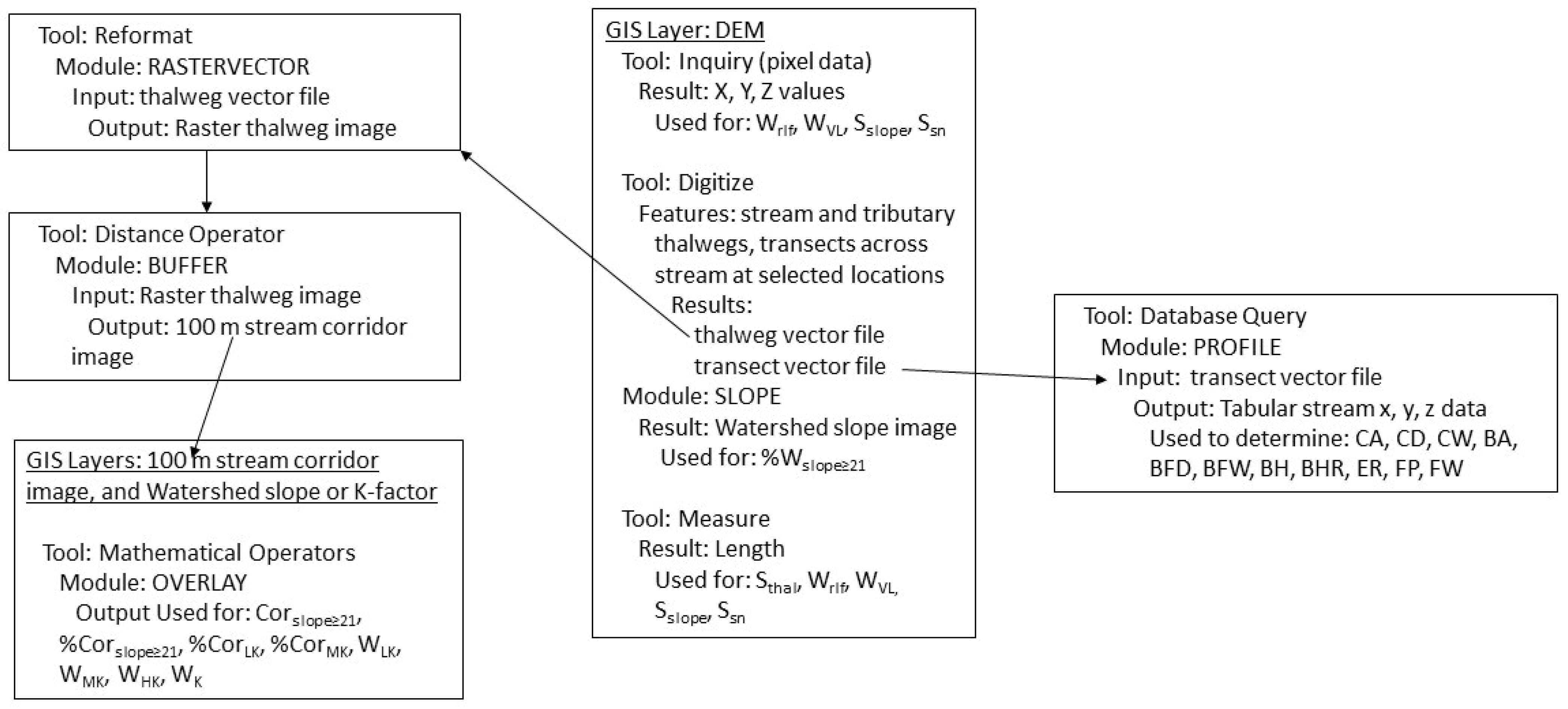
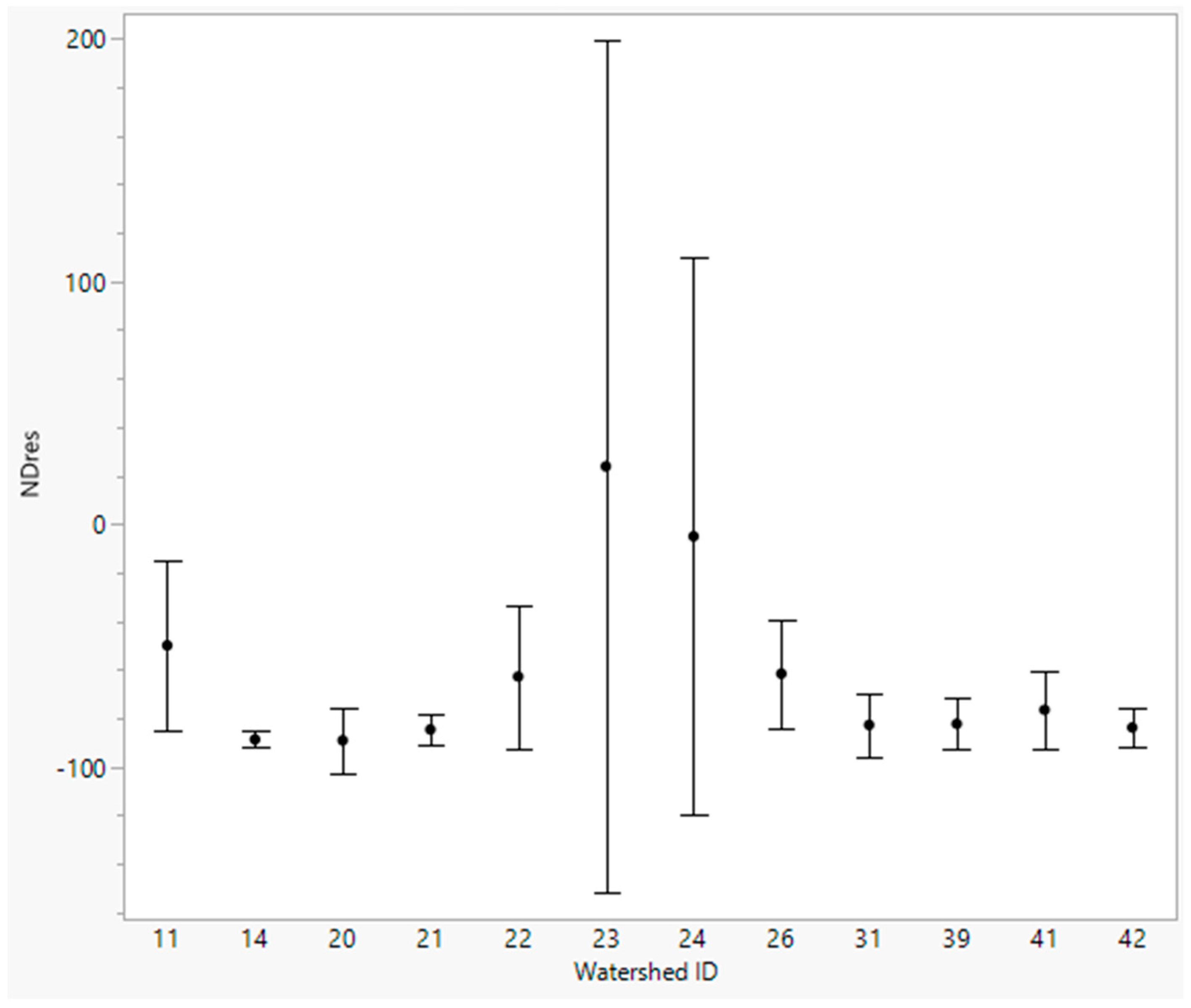
| NDRes (%) | ||||||
|---|---|---|---|---|---|---|
| SDR | n-Size | Mean * | Std. Dev. | CV | Min | Max |
| Equation (2) | 60 | −40.2 ab | 104.9 | 261.1 | −96.9 | 548.2 |
| Equation (3) | 60 | −61.9 b | 66.6 | 107.6 | −97.8 | 332.8 |
| Equation (4) | 60 | −45.6 ab | 94.6 | 207.5 | −96.9 | 518.7 |
| Equation (5) | 60 | −54.9 ab | 78.3 | 142.5 | −97.4 | 412.6 |
| K-Factors as a Decimal% of Watershed Area | ||||||||||||
|---|---|---|---|---|---|---|---|---|---|---|---|---|
| WS ID | 0 (Water Area) | 0.02 | 0.1 | 0.15 | 0.2 | 0.24 | 0.28 | 0.32 | 0.37 | 0.43 | 0.49 | WK |
| Low Erosivity | Moderate Erosivity | High | ||||||||||
| 11 | 0.0089 | 0.155 | 0 | 0.233 | 0.288 | 0 | 0 | 0.008 | 0.077 | 0.116 | 0.115 | 0.23 |
| 14 | 0.125 | 0.014 | 0 | 0.242 | 0.619 | 0 | 0 | 0 | 0 | 0 | 0 | 0.16 |
| 20 | 0.012 | 0.02 | 0.104 | 0.214 | 0.353 | 0 | 0.156 | 0 | 0.052 | 0.077 | 0.012 | 0.22 |
| 21 | 0.008 | 0.064 | 0.131 | 0.2 | 0.314 | 0 | 0.203 | 0 | 0.059 | 0 | 0.021 | 0.20 |
| 22 | 0.04 | 0 | 0.044 | 0 | 0.098 | 0 | 0.061 | 0 | 0.417 | 0.182 | 0.158 | 0.35 |
| 23 | 0.028 | 0 | 0.0001 | 0.015 | 0.078 | 0 | 0.205 | 0 | 0.493 | 0.137 | 0.044 | 0.34 |
| 24 | 0.022 | 0 | 0 | 0 | 0.011 | 0.011 | 0.154 | 0 | 0.599 | 0.113 | 0.089 | 0.36 |
| 26 | 0.028 | 0 | 0 | 0 | 0.0005 | 0.001 | 0 | 0 | 0.743 | 0 | 0.228 | 0.39 |
| 31 | 0.027 | 0.001 | 0.01 | 0.002 | 0.093 | 0.088 | 0.222 | 0 | 0.394 | 0.02 | 0.143 | 0.33 |
| 39 | 0.022 | 0.032 | 0 | 0.035 | 0.653 | 0.113 | 0.145 | 0 | 0 | 0 | 0 | 0.20 |
| 41 | 0.025 | 0 | 0 | 0.333 | 0.642 | 0 | 0 | 0 | 0 | 0 | 0 | 0.18 |
| 42 | 0.029 | 0 | 0 | 0.013 | 0.91 | 0 | 0 | 0 | 0.024 | 0.007 | 0.017 | 0.20 |
| Watershed Land Cover Group | ||||
|---|---|---|---|---|
| Statistic | Crop | Grass | Tree/Shrub | All |
| Maximum (%) | 332.8 | 8.9 | −56.1 | 332.8 |
| Minimum (%) | −97.5 | −93.4 | −97.8 | −97.8 |
| Mean (%) | −31.4 | −71.7 | −82.9 | −62.0 |
| Std. Dev. (%) | 106.5 | 27.0 | 12.2 | 66.6 |
| N-size | 20 | 20 | 20 | 60 |
| Crop | Grass | Tree/Shrub | |||
|---|---|---|---|---|---|
| Watershed ID | NDResT * | Watershed ID | NDResT | Watershed ID | NDResT |
| 24 | 0.809 a | 11 | 0.726 a | 41 | 0.476 |
| 23 | 0.743 a | 22 | 0.589 ab | 39 | 0.417 |
| 26 | 0.681 a | 21 | 0.370 bc | 42 | 0.383 |
| 31 | 0.387 b | 14 | 0.269 c | 20 | 0.222 |
| Watershed/Reservoir ID | Watershed Subdominant Land Cover Group | * NDResT |
|---|---|---|
| 24 | Crop | 0.809 a |
| 23 | Crop | 0.743 ab |
| 11 | Grass | 0.726 ab |
| 26 | Crop | 0.681 abc |
| 22 | Grass | 0.589 abcd |
| 41 | Tree/shrub | 0.476 bcde |
| 39 | Tree/shrub | 0.417 cde |
| 31 | Crop | 0.387 de |
| 42 | Tree/shrub | 0.383 de |
| 21 | Grass | 0.370 de |
| 14 | Grass | 0.269 e |
| 20 | Tree/shrub | 0.222 e |
| Soil K-Factor * | Topographic * | ||||
|---|---|---|---|---|---|
| Group ID | %CorLK | %CorMK | %CorHK | %Corslope>21 | Corslope>21:Wvl (m2 m−1) |
| 1 | 19.8 b | 71.9 a | 8.3 a | 7.7 | 15.4 a |
| 2 | 67.4 a | 31.6 b | 1.0 b | 13.8 | 5.2 b |
| Within-Channel Variables * | ||||||||||||
|---|---|---|---|---|---|---|---|---|---|---|---|---|
| Group ID | BFD (m) | BFW (m) | BFW:BFD | BA (deg) | BH (m) | BHR | ER | CD (m) | CW (m) | CW: CD | CA (m2) | FWA_ %WA |
| 1 | 0.65 | 15.3 | 43.2 | 17.9 | 3.0 | 5.8 a | 2.1 | 3.6 | 36.1 | 18.0 | 91.3 | 3.7 |
| 2 | 0.57 | 15.6 | 38.8 | 12.7 | 2.0 | 3.5 b | 4.5 | 2.4 | 38.8 | 36.0 | 70.0 | 2.7 |
| # Model Variables | Variables Used | RMSE (%) | R2 | Adjusted R2 | p-Value |
|---|---|---|---|---|---|
| 1 | LNWSK | 11.7 | 0.436 | --- | 0.0194 |
| NDRes = (117.3 × LNWSK) − 103.6 | |||||
| 2 | SHASHER, FWA_%WA | 7.8 | 0.775 | 0.724 | 0.0012 |
| NDRes = (−31.0 × SHASHER) + (7.1 × FWA_%WA) − 79.4 | |||||
| 3 | LNBFD, FWA_%WA,%ICK | 6.2 | 0.871 | 0.822 | 0.0006 |
| NDRes = (243.7 × %ICK) + (7.0 × FWA_%WA) − (30.7 × LNBFD) − 145.7 | |||||
| 4 | LNWK,LNWvl, LNCorslope≥21:Wvl, SHASHER | 3.4 | 0.967 | 0.948 | <0.0001 |
| NDRes = (62.5 × LNWK) − (64.8 × SHASHER) − (82.2 × LNCorslope≥21:Wvl) − (46.2) − 8.8 | |||||
| 5 | LNWA, LNWSK, LNWvl, LNCorslope≥21:Wvl, SHASHER | 1.9 | 0.991 | 0.984 | <0.0001 |
| NDRes = (41.1 × LNWA) + (86.5 × LNWK) - (107.7 × LNWvl) − (124.1 × LNCorslope≥21:Wvl) − (91.1 × SHASHER) | |||||
Disclaimer/Publisher’s Note: The statements, opinions and data contained in all publications are solely those of the individual author(s) and contributor(s) and not of MDPI and/or the editor(s). MDPI and/or the editor(s) disclaim responsibility for any injury to people or property resulting from any ideas, methods, instructions or products referred to in the content. |
© 2023 by the authors. Licensee MDPI, Basel, Switzerland. This article is an open access article distributed under the terms and conditions of the Creative Commons Attribution (CC BY) license (https://creativecommons.org/licenses/by/4.0/).
Share and Cite
Starks, P.J.; Moriasi, D.N.; Fortuna, A.-M. GIS-Based RUSLE Reservoir Sedimentation Estimates: Temporally Variable C-Factors, Sediment Delivery Ratio, and Adjustment for Stream Channel and Bank Sediment Sources. Land 2023, 12, 1913. https://doi.org/10.3390/land12101913
Starks PJ, Moriasi DN, Fortuna A-M. GIS-Based RUSLE Reservoir Sedimentation Estimates: Temporally Variable C-Factors, Sediment Delivery Ratio, and Adjustment for Stream Channel and Bank Sediment Sources. Land. 2023; 12(10):1913. https://doi.org/10.3390/land12101913
Chicago/Turabian StyleStarks, Patrick J., Daniel N. Moriasi, and Ann-Marie Fortuna. 2023. "GIS-Based RUSLE Reservoir Sedimentation Estimates: Temporally Variable C-Factors, Sediment Delivery Ratio, and Adjustment for Stream Channel and Bank Sediment Sources" Land 12, no. 10: 1913. https://doi.org/10.3390/land12101913
APA StyleStarks, P. J., Moriasi, D. N., & Fortuna, A.-M. (2023). GIS-Based RUSLE Reservoir Sedimentation Estimates: Temporally Variable C-Factors, Sediment Delivery Ratio, and Adjustment for Stream Channel and Bank Sediment Sources. Land, 12(10), 1913. https://doi.org/10.3390/land12101913





